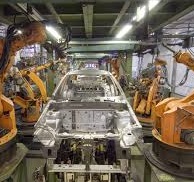“China could well turn out to be ground zero for the economic and social disruption brought on by the rise of the robots.”
Last November, the World Robot Exhibition was held in Beijing. It was an opportunity for the media to gawk at cute, dancing automations, and stoke unfounded fears about China’s “advanced armed attacked” robots (“Isn’t that just a PackBot with a rifle strapped to it?”).
It was also time to consider how important China is to the future of unmanned systems, especially those for industrial applications. According the International Federation of Robotics (IFR):
- China was the biggest market for robots in 2014.
- In 2014, Chinese factories accounted for about a quarter of the world’s industrial robots (54% increase over 2013).
- By 2017, China is projected to be home to the most robots of any country.
Source: International Federation of Robotics (IFR):
A good example of China’s commitment to unmanned systems is Foxconn, the maker of iPhones. Three years ago it announced that it would install 1 million robots in order to automate about 70% of factory work. It already has a fully robotic factory in Chengdu. Other Chinese companies are enthusiastically pursuing similar plans.
Opportunities for Western robot manufacturers
The path to widespread Chinese adoption of industrial robots is not without its obstacles. For one thing, Chinese-made robots have a significant quality problem.
Qu Daokui, chairman of Siasun Robot and Automation, a Shenyang-based industrial robot producer, stated in the South China Morning Post that quality is the number one challenge faced by Chinese robot manufacturers. This industry “lacks core technology,” he is reported to have said and is stuck at “low-end application in a high-end industry. As a result, it is under pressure of being marginalized in Western-dominated markets.”
Evidence for the quality problem is found in Foxconn’s troubled “Foxbot.” Difficulties with this robot forced the manufacturer to scale back its ambitious automation plans.
Some of the sources for poor quality can be tied to the relative newness of the Chinese robot industry. It is estimated that 15% are start-ups less than five years old. Chinese robot manufacturers still have not geared up production to meet demand and lack the latest technologies, such as 3-D printing.
Like everyone else in the world of robot business, AMREL is always on the lookout for new markets (we make Operator Control Units for unmanned systems). The poor quality of Chinese robots offer opportunities for foreign robot suppliers. China relies on imported key parts such as sensors and motors. In fact most robots are imported, as demonstrated by the chart below:
Source: International Federation of Robotics (IFR):
Ironically, Chinese industry which has made the world dependent on its manufacturing is itself dependent on foreign imports of industrial robots.
Jobs
However, quality and dependency on foreign imports are not China’s biggest robot problems. By far the biggest concerns are about job loss. Sixteen million factory jobs disappeared between 1995 and 2002, roughly 15% of total Chinese manufacturing employment. Many think that Chinese job loss caused by automation may be faster than it was in the West.
Chinese workers are already having a tough time. One survey states that 43% of Chinese workers consider themselves to be overeducated for their current positions. China’s dramatic reduction of poverty is historically unprecedented, but it has not translated into middle class lifestyle for most.
Furthermore, no one really understands the Chinese economy; it is a unique combination of wild infrastructure spending, state–directed capitalism, extremely high domestic savings rate, and poor incomes for typical workers. Many economists are hesitant to apply traditional models to the Chinese economy.
Add to the uncertainty about the impact of robotics on the economy and its workers, there is anxiety about basic Chinese social structure. The grip of the Chinese Communist Party is rock solid, but what happens when robot-created job loss hinders China’s extraordinary growth rate? Authoritarian regimes fear their people in a way that democracies don’t.
The whole world will be looking to see how China handles these challenges. Humanity has been dealing with job loss caused by automation for over a hundred years, and has yet to find a good answer.
The problem of robots and jobs can best be illustrated by an anecdote supposedly told about Walter Reuther, past leader of the United Auto Workers. An automobile company executive was showing the legendary union leader around a modernized factory floor. Pointing out the new industrial robots, the executive teased Reuther, “How are you going to collect union dues from all these machines?” Reuther replied, “That is not what’s bothering me. I’m troubled by the problem of how to sell automobiles to these machines.”
Have inside information about this topic? An opinion? Inappropriate jokes?
Send them to editor@amrel.com














